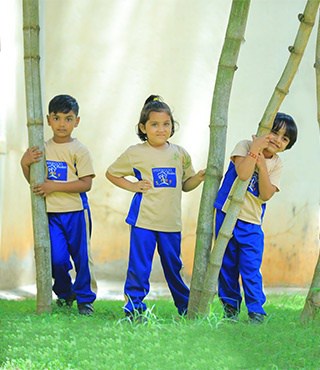
5 Simple Ways of Imbibing Gratefulness in Children
5 Simple Ways of Imbibing Gratefulness in Children
“Gratitude is the fairest blossom which springs from the soul.”–Henry Ward Beecher
Teaching your children gratefulness could mark the beginning of a lifelong sense of gratitude. It is imperative to strengthen the foundation of gratitude right from the beginning. Teaching them to say ‘thank you’ could probably be the first step, however, children learn to say thank you at a very young age, but do they understand the powerful sense the words carry? Maybe, or maybe not. So for them to be grateful we need to understand that it is not a natural behavior but something that needs to be taught.
However, many kids today take a lot of things for granted, as most of what they want is given to them without much thought. So teaching children today could be tricky and may feel like an uphill battle, but remember that irrespective of the challenges we might face, learning gratefulness in a world that seems to value overabundance is essential.
At Sherwood high we strongly believe in inculcating values of gratitude in our children, as practicing gratitude will not only teach children a lifelong quality to ignite positive emotions but will also build deeper bonds within family, friends, and social relationships. It will teach them to be happy and content with the situations they face at hand and find alternatives over complaining and cribbing in situations that they are not in control of. When children learn gratitude, their strengths are enhanced; like cooperation, respecting their capacity and working with others in various situations, flexibility, mindfulness of others, self, situations, environment, etc.
Importance of gratitude:
Many researchers have found that gratitude is linked to happiness in children, that is; instilling gratitude in your children from a young age could help them grow up to be happy people. According to a 2008 study published in the Journal of school psychology, grateful children tend to be happier, have better social support, and are more optimistic, they also report more satisfaction with their families, community, friends, school, and themselves, along with giving more social support to others as well.
By developing a sense of gratitude, children naturally tend to become more polite and kind towards others, as they are opened up into the world of others and they discover the world is more than just what they want and what they feel. By teaching children appreciation, you can help them become more optimistic and less prone to depression when they enter adulthood.

Teaching your children appreciation will give them perspective, as they become aware of the benefits and privileges they enjoy, which a lot many children in the world do not benefit from, it will make them appreciate their blessings more. It can also help foster genuine relationships in children, because of the perspective that gratitude generates.
According to the author of ‘Attitudes of Gratitude’, no child is born grateful, but it is something that needs to be inculcated by the parent. So, how can we teach gratitude to children?
Below are some ways of teaching children to be thankful and to count their blessings:
1. Teach children to say thank you:
Encouraging your children to say thank you regularly and offering gentle reminders like; “your brother gave you his toy, what would you like to tell him?” or “what do you say to uncle for giving you a chocolate?” might seem like forcing a mindless “thank you” without stirring up genuine gratitude, but it is still the first step in the process.
Verbally expressing appreciation can be an important learning tool for real gratitude, even if it doesn’t seem like a genuine appreciation when your child needs a reminder, so keep encouraging children to say ‘thank you’.
Make sure you appreciate children at times when they show gratitude with no prompting from you and praise pro-social behavior by saying things like; “I liked the way you thanked your teacher today” or “Good job remembering to say thank you to your grandfather”, as this kind of positive attention will reinforce the importance of showing gratefulness.
2. Modelling gratitude:
The best way to teach values such as gratitude is by example, and not just in theory. Our kids indeed take after us; that is our tone and our perspectives rub off on them. So you must show gratefulness when you speak to them; it could be something as simple as saying ‘thank you’ and ‘please’ to them, as well as your spouse and family members as often as possible.

3. Gratitude for the mundane and basic necessities:
Begin with something as simple as saying ‘how lucky we are to go out on such a bright and sunny day’ or ‘wow! Such beautiful weather and we are lucky to be out today as this teaches children to be grateful for the simplest and most mundane of things which often gets ignored by the majority.
Necessities such as food, water, milk, hygiene are also very essential to be appreciated by children. Though your children know that we buy rice or wheat from the store, they need to know how these things get to the store; that is how important the work of a farmer is, in helping them have the meal, or the person who packages it, or somebody who transported it to the city, to the stores or even delivered it to your homes. This way children will know that nothing comes easy and essentials such as necessities also have to be appreciated and not be taken for granted.
4. Teach them it goes beyond material things:
Many children tend to relate thankfulness to material possessions like toys, so make them understand that rather than being thankful for the toy, they should be thankful to the person who bought it for them. However, it is also important to emphasize that these are not just material gifts but are also gestures that must be treasured, as gifts are meaningful because a lot of thought, action, and love goes into buying them.
5. Acts of kindness:

Teach them the different ways of showing appreciation. Appreciation does not only mean saying thank you, but it could also be something entirely different; like returning a favor or helping someone in a required situation or could be an act of service etc.
Emphasize to your children that there are many ways to show people, you are grateful for what they do; it could be somebody as simple as your house help, people who serve you at a restaurant, a friend who helps with notes when they are on leave, their teacher, their grandparents, parents, family and the community at large for all they do.
Conclusion:
Along with the above-said things, experiment with different strategies to help determine which practices help your children best to learn, imbibe and express their grateful feelings.
As parents, we must understand that our children will not imbibe this quintessential habit all of a sudden. It may take children days, weeks, months, or even years, but parents need to stay calm and help children in any way possible to cultivate the habit of gratitude without giving up.
Also, make gratitude a priority in your homes. This will not only benefit your child, but the adults will also get the much-needed boost for everything they do.






